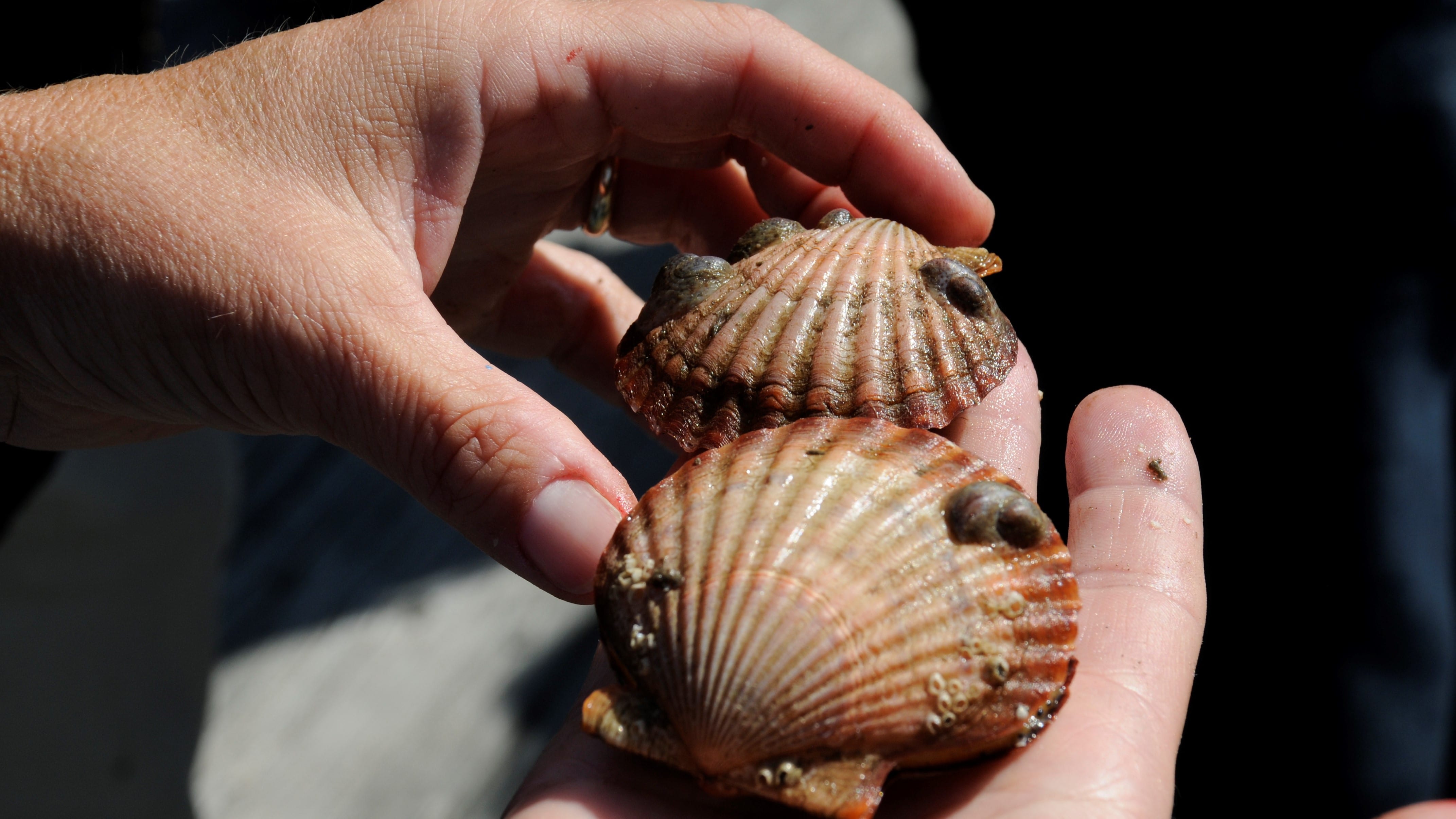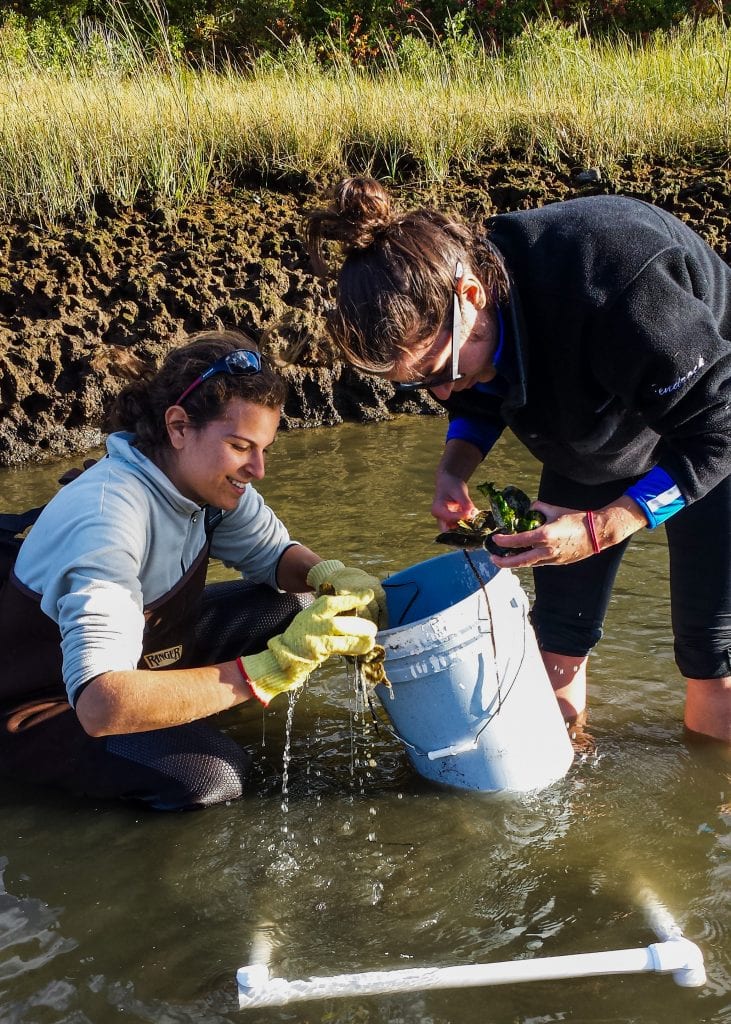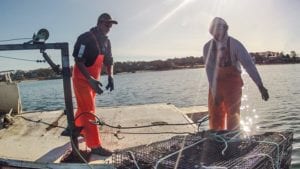Ocean acidification gets a watchful eye in New England aquaculture ‘hot spot’
By Evan Lubofsky | December 3, 2019

Shellfish aquaculture is thriving in New England—some estimates suggest the market value tops $50 million. But the future of the industry’s growth is only as good as the ability of shellfish to build strong shells.
And that could prove challenging in decades to come as coastal waters in the region become more acidic, according to Jennie Rheuban, a research associate at Woods Hole Oceanographic Institution (WHOI).
“Coastal acidification here in Massachusetts is a real concern, as it can prevent mollusks from growing shells and affect how long it takes for them to reach a harvestable size,” says Rheuban. “Aquaculture businesses haven’t seen the effects yet, but the industry is vulnerable and could be at risk in the future.”
Ocean acidification stems from a variety of factors, including rising CO2 levels in the atmosphere and ocean, nutrient pollution from septic systems, wastewater treatment plants and fertilizer use, and freshwater input from rivers. These variables cause pH level in the ocean to decline—either directly or indirectly—which sours the seawater and reduces its supply of calcium carbonate, a chemical compound that shellfish rely on to build their shells.
Rheuban, along with colleagues Daniel McCorkle at WHOI, Rachel Jakuba of the Buzzards Bay Coalition, and Scott Doney from the University of Virginia, recently concluded a multiyear study that involved monitoring water quality conditions at 11 sites in five embayments of Buzzards Bay, Massachusetts, to better understand the dynamics behind the bay’s increasing acidity. Specifically, the monitoring program was aimed at quantifying the impact of nutrient pollution on acidity levels—something that required the scientists to “disentangle” nutrient loads from the bay’s natural driver of acidification: fresh water.

WHOI research associate Jennie Rheuban (left) and MIT-WHOI Joint Program student Michaela Fendrock count and measure oysters at an oyster reef in West Falmouth, Massachusetts. (Photo by Kirsten Karplus, West Falmouth Oyster Reef Demonstration Project Volunteer)
“River input can play a significant role in acidifying estuaries since, here in New England, fresh water tends to have low alkalinity and is already naturally acidified when it reaches the coastal environment,” says Rheuban.
Isolating the two variables involved comparing water measurements from the bay with the chemistry profiles of both coastal source water and freshwater entering the bay. During the analysis, the researchers could see that in embayments with poor water quality, nutrient pollution accounted for roughly 50% of the acidification levels. Then, using results from nutrient loading modeling efforts completed though the Massachusetts Estuaries Project, the researchers were able to use that information to estimate how much the acidification problem could be alleviated if nutrient loads were reduced.
“Embayments that are already strongly influenced by nutrient pollution could see improvements by as much as an 80% increase, while those that are relatively pristine will not see much change since the water quality is already better,” says Rheuban.
The results were published in the journal JGR Oceans earlier this month.
Jakuba, science director at the Buzzards Bay Coalition, says that a key focal point of the Massachusetts Estuaries Project was how much nutrient reduction was needed for clear waters with healthy bottom sediments where eelgrass could thrive.
"This study shows that nutrient reductions will have the additional benefit of improving the growing conditions for shellfish," she says.
Doney agrees, and says that reducing nutrient pollution on a local level may help mitigate the broader problem of carbon emissions on coastal acidification.
"Local solutions may be a good adaptation strategy for offsetting acidification from rising atmosphere CO2, a global problem requiring more complex, international action on carbon emissions,” he says.
Rheuban points out that this particular study went beyond monitoring pH levels in the bay.
“Unfortunately, measuring pH alone is not enough to tell you the level of detail needed,” she says. “You need to understand other chemical parameters that may be impacting an animal’s ability to grow a strong shell.”
She says the calcium carbonate “saturation state” of the seawater—an indicator of a shell’s likelihood to dissolve or remain solid—was a key parameter she and her colleagues measured during the two-year monitoring effort. Saturation state is based on a critical threshold value of 1; shells in seawater with a saturation state of less than 1 are more likely to dissolve, while those in seawater above 1 are more likely to stay solid.
“In some of the most polluted places we studied, nearly every measurement we collected had a saturation state of less than 1, which is a concerning trend when thinking about it from an aquaculture standpoint,” says Rheuban.
Dan Ward, owner of Ward Aquafarms in North Falmouth, Massachussets, shares Rheuban's concern.
"I'm concerned about our bay scallops, since they have not adapted to live in these acidic conditions over long periods of time," says Ward. "And if our waters become more acidic, I'm also concerned about the impact it will have on natural recruitment in the region."

Harrison Tobi (left) and Matt Cotter from Ward Aquafarms deploy an oyster cage in Megansett Harbor. (Photo courtesy of Ward Aquafarms)
Rheuban says that linking nutrient load reductions to potential improvements in the bay heath is an important step toward cleaner and less acidic harbors in the Baystate. But she hopes the study also could provide a “monitoring framework” that the state could use to identify other coastal regions throughout Massachusetts where coastal acidification could be alleviated—particularly those that depend heavily on aquaculture. This, in turn, could help inform the state’s Special Commission on Ocean Acidification, which is charged with identifying the extent of the coastal acidification problem and making policy recommendations on how to fix it.
“Coastal water quality has declined throughout many of Massachusetts’ coastal embayments.” says Rheuban. “This problem is local, and has local solutions. If we can turn things around, there’s a chance that more farming grounds could be established in the future, expanding the thriving aquaculture landscape we already have here.”
This work is funded by the John D. and Catherine T. MacArthur Foundation, MIT Sea Grant, and the West Wind Foundation.
